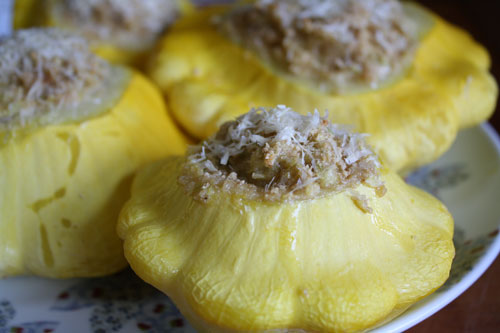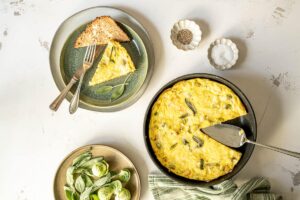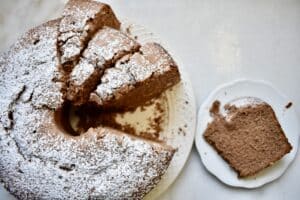
Dinner Table Rating
1 thumb per family member
Cook’s Rating
Accessibility of ingredients, ease of preparation, and affordability
Look at me keeping my promises! Another winning squash recipe. Stuffed squash has been in my cooking repertoire for nearly as long as I’ve been married. But I always did sort of think of it as a last resort for zucchini. You know, “If you can’t do anything else with it, stuff it (or fry it) and they’ll eat it.” But this recipe changed my mind about that. It just seems so much healthier than other recipes I’ve made. In order to understand it as healthy, you do have to understand the Nourishing Traditions concept that high-quality cream really can be good for you, especially if you have cultured it with all kinds of good-for you friendly bacteria. If this is a new concept for you, and you want to understand why Sally Fallon believes this, here is a very informative (and somewhat scientific) article by Sally on the benefits of saturated fat. You have to understand that the kind of cream you buy out of the case at, say, Super Wal-Mart is not good for you. It’s been highly refined and has had its chemical structure altered through that refinement. However, cream from a local farmer or even some of the cream out of the dairy case at a health food store (I buy this brand) can be incredibly good for you.
This recipe got five thumbs at the dinner table. It would have gotten six if I’d been able to eat it. When the Peanut saw it, she said “Wooow!”, which is her only word other than “Mama”. She was very impressed. I didn’t award the Ease of Preparation star simply because I find hollowing out vegetables and stuffing them again a bit tedious. The results are entirely worth the effort, it’s just tedious.
Stuffed Zucchini (Nourishing Traditions, page 411)
- 8 small or 4 large zucchini
- 2 onions finely minced
- 3⁄4 cup crispy almonds (p 515) ground
- 3⁄4 cup piima cream or creme fraiche (p 84)
- 1 cup whole grain bread crumbs
- 3⁄4 cup grated swiss or parmesan cheese
- 2 organic eggs
- 1⁄4 tsp powdered cloves
- sea salt and pepper
1. Remove ends of the zucchini and cook in boiling, salted water about 8-10 minutes, depending on the size of the zucchini, or until flesh becomes just tender. Remove to a colander and rinse with cold water. Slice in half lengthwise and scoop out the flesh, reserving it in a bowl. Salt the inside of the zucchini shells and turn over to drain on paper towels.
I used some pretty giant pattypan squash that we had in the fridge. I liked the presentation they made, though I do think the traditional zucchini would be much easier to hollow out.
Again, I question Sally’s method of salting the zucchini. My guess is that she intends for this to draw out any remaining water in the shells so that your zucchini will hold their shape better. I did an experiment this time, salting two shells and not salting the other two shells. I put all four of them upside down to drain. I couldn’t find a difference between the ones that I salted and the ones that I didn’t. If you, too, have four kids calling for their dinner and want to skip this step, I think it’s safe to say you can.
2. Meanwhile, saute onion in olive oil. Chop zucchini flesh, squeeze out water and add to the onion. Cook a few minutes more.
We had a leek in the fridge from a friend’s farm, so we used that instead of the onion. I used my food processor to make quick work of chopping the zucchini flesh. Do be sure to squeeze, and squeeze, and squeeze to remove as much water as possible. I like to put mine in a fine-meshed colander and press down on it over and over again. All the water goes straight out the bottom.
3. Beat the eggs and cream together. Stir in the onion and zucchini mixture, the almonds, about half the bread crumbs, half the cheese and the powdered cloves. Season to taste. If the mixture is too runny, add more bread crumbs.
If you don’t have the ingredients for piima cream, some high-quality, organic sour cream or yogurt would probably be “good enough”. Though you’ll be missing out on all those good-for-you bacteria that come from culturing your own.
When I pulled out my crispy almonds they smelled a little rancid. I’m an economical person and hate throwing away food. In the past, I’ve usually used those rancid nuts anyway. But I’ve been learning about how bad that is for you and decided to pitch them this time. Luckily, I keep a huge bag of almond flour on hand for my gluten-free baking, so I just substituted some of that. If your nuts smell “off”, don’t eat them.
As opposed to adding more bread crumbs, I let my stuffing sit on the counter for a minute or two, which allowed the bread crumbs to soak up some liquid and made the filling thicker. Do whatever suits your preference and fits your time-table.
4. Arrange zucchini shells in a buttered casserole and fill with the stuffing. Sprinkle remaining bread crumbs and cheese on top. You may prepare ahead to this point, and refrigerate the zucchini until you want to bake it. Bake at 350 degrees for about 1/2 hour or until tops are golden.
You know, the other thing I appreciated about this recipe is that it’s the first stuffed zucchini I made where I wasn’t trying to cram it all back into the shells. The amount was just perfect to fill the shells back up. I even scraped the bowl.










